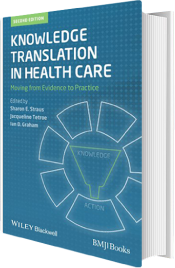This step is necessary to determine how and to what extent the knowledge has diffused through the target decision maker groups. How we proceed to measure knowledge use depends on our definition of knowledge and knowledge use and on the perspective of the knowledge user. We find it useful to consider conceptual, instrumental and persuasive knowledge use:
- Conceptual use of knowledge implies changes in knowledge, understanding or attitudes. Research could change thinking and inform decision making but not change practice.
- Instrumental knowledge use is the concrete application of knowledge and describes changes in behaviour or practice, for example. Knowledge can be translated into a usable form, such as a care pathway, and is used in making a specific decision.
- Persuasive knowledge use is also called strategic or symbolic knowledge use and refers to research being used as a political or persuasive tool. It relates to the use of knowledge to attain specific power or profit goals.
How can knowledge use be measured?
In addition to considering the type of knowledge use, we should also consider who are the targets for knowledge use. Different targets may require different strategies for monitoring knowledge use. The target level of knowledge use will be based on discussions with relevant stakeholders including consideration of what is acceptable and feasible and whether a ceiling effect may exist. If the degree of knowledge use is found to be adequate, strategies for monitoring sustained knowledge use should be considered. If the degree of knowledge use is less than expected or desired, it may be useful to reassess barriers to knowledge use.
When should we measure knowledge use versus the impact of knowledge use? If the implementation intervention targets a behaviour for which there is a strong evidence of benefit, it may be appropriate to measure the impact of the intervention in terms of whether the behaviour has occurred (instrumental knowledge) rather than whether a change in clinical outcomes has occurred.
For example, we recently completed a study of a strategy to implement the Osteoporosis Canada guidelines in a northern Ontario community setting. The primary outcome of this randomized trials was appropriate use of osteoporosis medications (instrumental knowledge) rather than patient fractures (clinical outcome). We felt that there was sufficient evidence in support of use of osteoporosis medications to prevent fragility fractures that we did not need to measure fractires as the primary outcome. In cases such as this study, outcome measurement at the patient level could be prohibitively expensive but failure to measure at the patient level does not address whether the intervention improves relevant clinical outcomes.
Evaluating the Impact of Knowledge Use
The next phase of the knowledge-to-action cycle is to determine the impact of knowledge implementation. In this phase, we want to determine if the knowledge use impacts health, provider, and system outcomes. While assessing knowledge use is important, its use is of particular interest if it influences important clinical measures, such as quality indicators. Evaluation should start with formulating the question of interest using the PICOST framework.
In the previous section, we described strategies for considering knowledge use, which can be used to frame outcomes. A framework for considering quality of care that separates quality into structure, process, and outcome is described below.
- Structural indicators focus on organizational aspects of service provision that could be analogous to instrumental knowledge use.
- Process indicators focus on care delivered to patients and include when evidence is communicated to patients and caregivers. These indicators are analogous to instrumental knowledge use.
- Outcome indicators refer to the ultimate goal of care, such as patient quality of life or admission to hospital.
In a systematic review of methods used to measure change in outcomes following a KT intervention, measures were grouped into three main categories, which we have modified to focus on impact of knowledge use:
- Patient Level – Measure of an actual change in health status, such as mortality or quality of life
- Health Care Provider Level – Measure of provider satisfaction
- Organizational or Process Level – Measure of change in health care systems or costs

